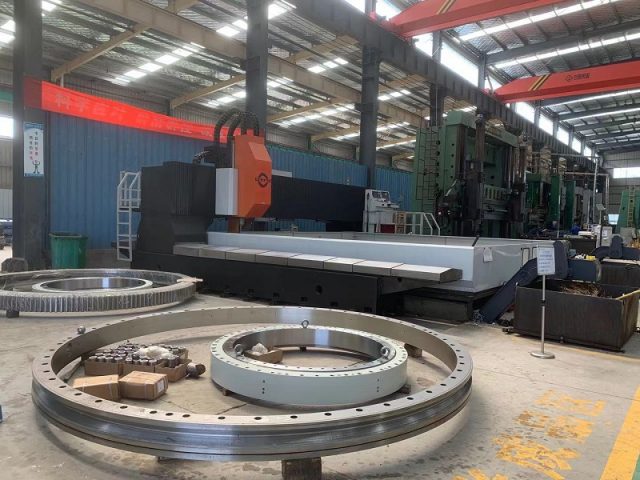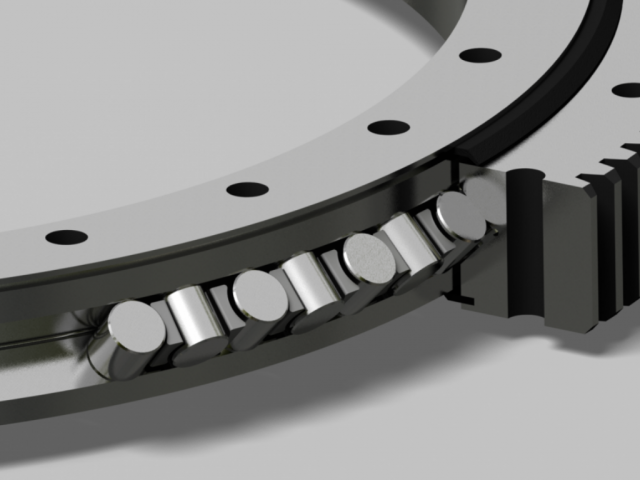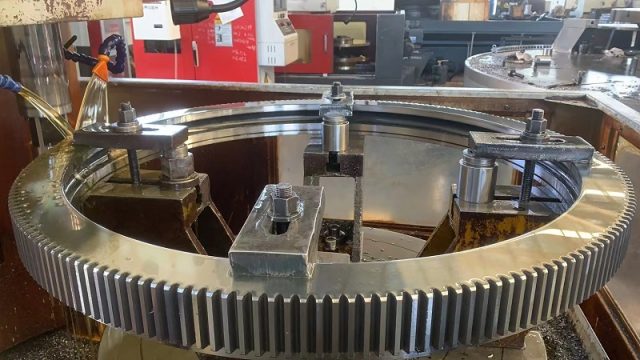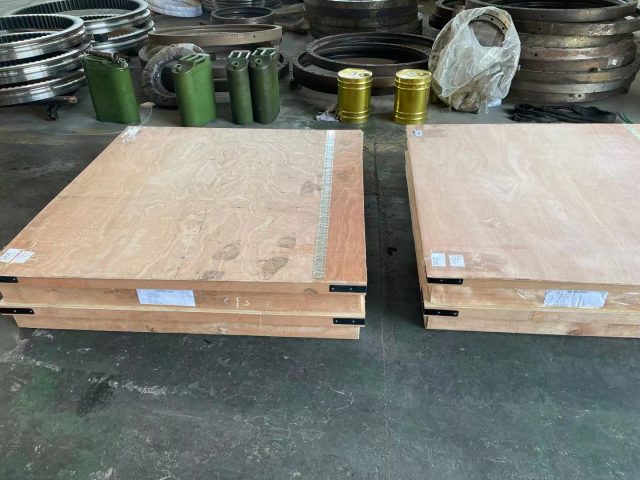Ball bearing slewing ring
Table of Contents
Ball bearing slewing ring

Four-point contact ball bearings, double-row ball bearings, and double-row different diameter ball bearings are all typical point contacts. In the case of rotation, it can be understood as two concentric circles or four concentric circles. Ball bearing slewing ring, Actually The precision of processing is very demanding. The advantages are flexibility, fatigue resistance, convenient maintenance, quick installation, easy accuracy, long life, but the stability is slightly inferior to the cross roller and the three-row roller in the long run.
Ball bearings, mainly cross-roller bearings and three-row roller structures, Ball bearing slewing ring , line contact, in the state of motion, can be understood as surface contact, low speed and heavy load, high reliability and stability, but the speed and flexibility are obviously not as good as four points Contact the ball bearing.
The working conditions need to decide everything. In a general sense, four-point ball bearing can handle 80% of the working conditions. Special customization requires special design.
Rothe erde ball bearing slewing ring
1. The scientific name of the slewing bearing is the slewing ring. Before the slewing ring is selected, the operating environment and working conditions must be clarified.
2. Determine the maximum load of the slewing bearing. This load must include both the dynamic load and the static load applied to the slewing ring. The load applied to the ring should be converted into an equivalent load acting on the center of the slewing ring. Some things that must be noted:
· All external forces acting on the slewing ring and gear, not only the rated load or working load, but also the load that may occur suddenly when the equipment is stationary, such as the effect of strong wind on large buildings, etc.
· The load that may be generated in the case of overload or test
· Loads generated during installation and removal
· The weight of all structures supported by the slewing ring
· The sum of all possible loads. For example, a crane has various changes in load and working radius during normal use and overload test.
3. Multiply the calculated load by an appropriate safety factor.
4. Ball bearing slewing ring If you need a complete gear, you need to determine the load that the gear needs to bear. The calculation method is the same as that of the slewing bearing load, and all possible situations should be considered; to give a few examples, these situations include working, static, tilting, and overload testing. Another thing to pay attention to is the type of load in each case.
5. Ball bearing slewing ring After determining the installation layout, you need to consider the location of the large and small gears, the installation of the slewing ring and the fastening bolts, and the follow-up maintenance issues.
6. Ball bearing slewing ring Refer to the “Product Overview & Selection Guide” in the Wanda Slewing Ring Operation Manual to select the slewing ring series required for each location.
7. By comparing the previously calculated load and safety factor of the slewing ring with the load-bearing characteristic curve of the slewing ring, we can make a preliminary selection of the slewing ring. Be sure to ensure that all load combinations are below the load-bearing characteristic curve. In many cases, we now have several slewing bearings to choose from, all of which can meet the load requirements.
8. If possible, check the gear load capacity of the selected slewing ring.
9. Confirm that the arrangement of fixing bolts, fixing plates and joints are suitable for installation.
2. Selection elements of slewing bearings
Slewing bearings ,Ball bearing slewing ring have unique load-bearing characteristics and are usually used in hoisting machinery, excavators, turrets, wind turbines, telescopes and tank turrets. Ball bearing slewing ring Through the improvement of machining methods and the upgrading of design, the slewing bearing at this stage can be used in smaller, more complex and more precise occasions.
The correct selection of slewing bearings depends on the requirements of load, stiffness, speed, size and rotational flexibility. Customers and manufacturers jointly select the design goals and the applicability of the bearing, which helps to optimize the performance of the system under the premise of the lowest cost and guaranteed trouble-free operation. Usually the load capacity is the decisive factor in choosing the bearing section size and diameter, but other parameters determine which bearing type is the best.
1. In general, double row four-point contact ball bearings are required for larger torque requirements.
2. Generally, roller bearings are required to increase rigidity.
3. The maximum load carrying capacity requires the use of cross rollers (two-row or three-row roller bearings)
For occasions requiring increased rigidity and load-bearing, large-size bearings are required, but for occasions with sensitivity requirements such as robots and manipulators, small-size bearings are required. The slewing bearing with a smaller inner diameter size makes the structure of the mounting component more compact and the total weight is reduced.
Ball bearing turntables and slewing rings
1. Ball bearing slewing ring can Dimensions, especially the stop, step size, relative position of the lubrication hole
2. Gear parameters, core key parameters
3. Quenching, channeling, and tooth roots
4. Gear center diameter
5. Mounting hole size, category, center diameter, wire hole size and type, key parameters
6. Original accuracy
7. Upgrade and promotion of installation conditions.
Ball bearing supported slewing ring
What is ball bearing ring?
If the basic rotation is achieved, the load is not high, and the overturning moment is not large, the four-point ball bearing is sufficient.
If good rotation performance is required, and the load is more than 10 tons, double volleyball is the best choice.
To emphasize the rotation accuracy, consider the crossed roller bearing, of which the accuracy of the tapered roller bearing ,Ball bearing slewing ring is the most appropriate.
Selection and Application of Bearings for Slewing Bearings of Rotary Turntable
Three-row cylindrical rolle r bearings are the ultimate design goal, and corresponding changes are made in the size and material of the rollers to obtain different force enhancements.
Of course, the cost has also increased. According to different working conditions, the material of the bearing, the cage and the sealing system have targeted designs, divided into categories to facilitate the better and stronger operation of the equipment. This is where the strength of Luoyang Bearing.
What are the benefits of using ball bearing?

Slewing bearings ,Ball bearing slewing ring and double-row ball bearings have not been well-known for a long time.
First, many devices mostly use four-point contact ball bearings, but for double-row ball bearings, they ignore or adopt other structures. In fact, analyze the characteristics of double-row ball bearings as follows:
1. Realize good rotation performance
2. Anti-permanent fatigue
3. The load is relatively in the middle, that is, between the four-point kick and the three-row roller bearing, such as 15 to 40 tons cranes, crane cranes, cement pump trucks, etc.
4. Maintenance Convenient
5. Long service life.
Three-row roller bearings, considering the ultimate choice of heavy load and overturning moment, the technical characteristics are as follows:
1. Load more than 100 tons
2. Impact load, partial load and heavy load and complex force
3. Low speed
4. Lubrication system is relatively Complex 5. High cost
What are the ball bearings where are they used?
https://www.youtube.com/watch?v=Dqwgxx1_9ac
What are the general selection steps for slewing bearings , Ball bearing slewing ring?
1. The scientific name of slewing bearings is slewing ring.
Before slewing ring selection, the operating environment and working conditions must be clarified. 2. Determine the maximum load of the slewing bearing.
This load must include both the dynamic load and the static load applied to the slewing ring. The load applied to the ring should be converted into an equivalent load acting on the center of the slewing ring.
Some things to pay attention to: · All the external forces acting on the slewing ring and gears are not only the rated load or working load, but also the load that may occur suddenly when the equipment is stationary, such as the effect of strong wind on large buildings, etc. ·
In The load that may be generated in the case of overload or test, the load generated during installation and disassembly, the weight of all structures supported by the slewing ring, and the sum of all the possible loads.
For example, a crane has multiple changes in load and working radius during normal use and overload test.
3. Multiply the calculated load by an appropriate safety factor.
4. If you need a complete gear, you need to determine the load that the gear needs to bear. The calculation method is the same as that of the slewing bearing load, and all possible situations should be considered; to give a few examples, these situations include working, static, tilting, and overload testing. Another thing to pay attention to is the type of load in each case.
5. After determining the installation layout, you need to consider the location of the large and small gears, the installation of the slewing ring and the fastening bolts, and the follow-up maintenance issues.
6. Refer to the “Product Overview & Selection Guide” in the Wanda Slewing Ring Operation Manual to select the slewing ring series required for each location.
7. By comparing the previously calculated load and safety factor of the slewing ring with the load-bearing characteristic curve of the slewing ring, we can make a preliminary selection of the slewing ring.
Be sure to ensure that all load combinations are below the load-bearing characteristic curve. In many cases, we now have several slewing bearings to choose from, all of which can meet the load requirements.
8. If possible, check the gear load capacity of the selected slewing ring.
9. Confirm that the arrangement of fixing bolts, fixing plates and joints are suitable for installation.
2. Selection elements of turntable bearings Turntable bearings have unique load-bearing characteristics, and are usually used in hoisting machinery, excavators, turntables, wind generators, telescopes and tank turrets.
Through the improvement of machining methods and the upgrading of design, the slewing bearing at this stage can be used in smaller, more complex and more precise occasions.

The correct selection of slewing bearings depends on the requirements of load, stiffness, speed, size and rotational flexibility. Customers and manufacturers jointly select the design goals and the applicability of the bearing, which helps to optimize the performance of the system under the premise of the lowest cost and guaranteed trouble-free operation. Usually the load capacity is the decisive factor in choosing the bearing section size and diameter, but other parameters determine which bearing type is the best.
1. In general, double row four-point contact ball bearings are required for larger torque requirements.
2. Generally, roller bearings are required to increase rigidity.
3. The maximum load carrying capacity requires the use of crossed rollers (two-row or three-row roller bearings).
For occasions that require increased rigidity and load-bearing, large-size bearings are required, but for occasions with sensitivity requirements such as robots and operating devices, then Need to use small size bearings.
The slewing bearing with a smaller inner diameter size makes the structure of the mounting component more compact and the total weight is reduced. At the same time, for the occasions with higher speed and small structural deformation, it also reduces the moment of inertia.
How does ball bearings reduce friction?

1. Ball bearing slewing ring The accuracy of the transmission movement. The angle error of the gear in one revolution is required to be limited within a certain range, so that the gear pair transmission ratio changes little to ensure the accuracy of the transmission movement.
2. The smoothness of the transmission movement. Ball bearing slewing ring It is required that the rotation angle error within the range of one tooth of the gear is limited to a certain range, so that the instantaneous transmission ratio of the gear pair changes little, so as to ensure the smoothness of the transmission and reduce vibration, impact and noise.
3. Uniformity of load distribution. It is required that the working tooth surface in the transmission is in good contact to ensure uniform load distribution, otherwise it will cause the tooth surface stress concentration, premature wear and reduce the service life.
4. The rationality of the transmission backlash. It is required to leave a certain amount of backlash between the non-working tooth surfaces of the meshing gear teeth in order to store the lubricating oil, compensate for the elastic deformation and thermal deformation, and the manufacturing and installation errors of the gear.
What is the difference between ball bearing and roller bearing?
The accuracy and reliability of the three-row roller bearing crossed roller bearing and the four-point ball bearing are high? In fact, there is only more suitable, there is no difference between high and low.
From the technological point of view, Ball bearing slewing ring , three-row roller bearings are flat raceways.
Relatively speaking, the rotation accuracy is easier to achieve and meet. Taking the limit accuracy of 0.015 as an example, this end face runout is difficult to achieve, especially for large-diameter slewing bearings. . The advantage is that three-row roller bearings have the advantages of heavy-duty and high-precision bearings, and are widely used in shield machine bearings, ladle bearings and other high-precision turntables.
The cross-roller structure has special forces, uniform axial and radial forces, good rigidity, and deformation resistance. It can be said that it is leading in the field of bucket wheel bearings and stacker-reclaimer bearings.
1797/3230 and 1797/2635, as well as the smaller model 1797/2500, can dominate the entire field of bucket turbines. In power plants, bucket turbines and turntable bearings in thermal power plants are in the position of big names in the world. Generally speaking, it is appropriate to achieve good high rigidity and preload. Disadvantages, low speed limit, inflexibility, there will be ball crashing sound above 6RPM per minute.
The four-point ball slewing bearing has more than flexibility and controllable precision. The key is to cooperate with the integral cage, copper cage, steel cage, and PTFE cage. It is fully qualified for different equipment fields. It is definitely the top beam, the vanguard and Sniper. It is widely used in winding machine bearings, CT machine bearings, bottle blowing machine bearings, filling machine bearings and injection molding machine bearings. The characteristic is that it can adapt to high speed.
Do ball bearings need a cage?
Regardless of whether the slewing bearing is a ball bearing or a ball bearing,Ball bearing slewing ring the spacer and the cage are indispensable.
Ball bearing slewing ring The role of the cage:
1. Reduce the friction between the rolling elements
2. Coordinate, distribute and guide the direction and trajectory of the rolling body
3. Standardize the force balance of rolling elements
4. On the basis of bearing forces, especially vertical, inclined and multi-directional forces, the application of integral cages and segmented cages is very necessary to prevent rolling bodies from squeezing during gravity and movement. Hard friction
5. Among high-speed bearings, the integral cage is the first factor in the design
6. In order to reduce friction, noise and wear, the application of copper cage, PTFE cage and PA66 cage is very critical.
Slewing ring Bearing – Port Crane Slewing Bearing
Ball bearing slewing ring
1. Material
2. Heat treatment
3. Clearance, runout, tooth jump
4. Comprehensive index, roughness, tooth grinding, depth of hardness layer, flaw detection
5. Reference life value of similar bearing operation
Ball bearing slewing ring
The quality inspection of slewing ring bearings can be divided into axial clearance and radial clearance according to different inspection methods. Radial clearance is the basis for the assembly of the inner group, outer ring and rolling element of the bearing, and the quality is carried out in accordance with national standards. Important items for testing.
From the perspective of bearing application, the clearance is an important indicator for testing. Whether the bearing can obtain a more satisfactory performance, which largely determines its radial clearance.
The specific testing is as follows: the high-frequency quenching hardness of the bearing surface should not be less than 55HRC, the depth of the hardened layer should not be less than 4mm, and the width of the soft belt should not be less than 50mm.Ball bearing slewing ring, The entire processing process should be made according to customer needs.
Support bearings have certain requirements for quenching time and temperature for tempering. Under normal circumstances, they need to be quenched at a temperature of 200 degrees to ensure that all stresses disappear.
In addition, the most important thing is the grinding process. It is necessary to select a suitable grinding wheel to complete the grinding and strictly control the linear speed to avoid raceway burns.
Ball bearing slewing ring ,Then for fine grinding, you need to choose a 46° or 60° resin wheel for grinding. The amount of grinding cannot exceed that of rough grinding, and the finish must meet the requirements of the specified grade. For supporting bearings containing gears, after the grinding process, the gear hobbing process is required. The entire process is very strict, and the accuracy must exceed eight levels.

